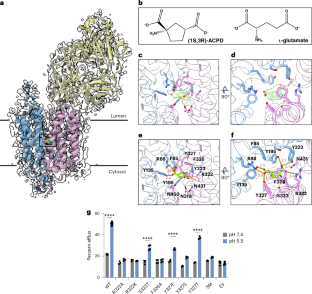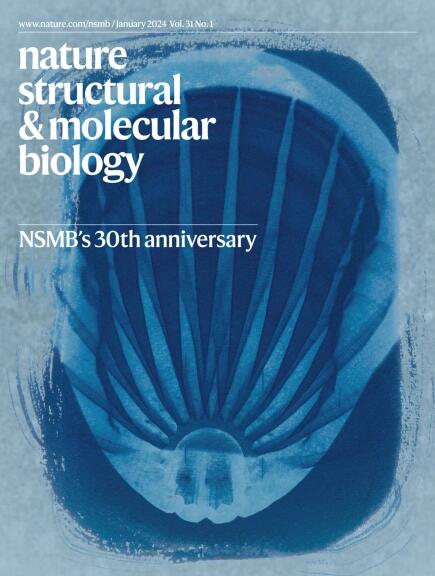Substrate recognition and allosteric regulation of synaptic vesicle glutamate transporter VGLUT2
IF 10.1
1区 生物学
Q1 BIOCHEMISTRY & MOLECULAR BIOLOGY
引用次数: 0
Abstract
The concentration of neurotransmitters inside synaptic vesicles (SVs) underlies the quantal nature of synaptic transmission. Uptake of glutamate, the principal excitatory neurotransmitter, is driven by membrane potential. To prevent nonquantal efflux of glutamate after SV exocytosis, the vesicular glutamate transporters (VGLUTs) are allosterically inhibited by the neutral pH of the synaptic cleft. To elucidate the mechanism, we determined high-resolution structures of rat VGLUT2 with a cyclic analog of glutamate. We propose a mechanism of substrate recognition in which a positively charged cytoplasmic vestibule electrostatically attracts the negatively charged substrate. We also identify modification of VGLUT2 by palmitoylation and find that this promotes retrieval of the transporter after exocytosis. The structure also reveals an extensive network of electrostatic interactions that forms the cytoplasmic gate. Functional analysis of a mutant that disrupts the network shows how this cytoplasmic gate confers the allosteric requirement for lumenal H+ required to restrict VGLUT activity to SVs. Guided by a structure of VGLUT2 with substrate, Li et al. identify the mechanisms for selective substrate recognition, a role for lipid modification in limiting axonal dispersion and for the cytoplasmic gate in allosteric regulation by lumenal H+.


突触小泡谷氨酸转运蛋白VGLUT2的底物识别和变构调节
突触囊泡(SVs)内的神经递质浓度决定了突触传递的量子性质。摄取谷氨酸,主要的兴奋性神经递质,是由膜电位驱动的。为了防止SV胞吐后谷氨酸的非定量外排,泡状谷氨酸转运蛋白(VGLUTs)被突触间隙的中性pH变构抑制。为了阐明其机制,我们用谷氨酸环类似物测定了大鼠VGLUT2的高分辨率结构。我们提出了一种底物识别机制,其中带正电的细胞质前庭静电吸引带负电的底物。我们还通过棕榈酰化鉴定了VGLUT2的修饰,并发现这促进了胞吐后转运蛋白的恢复。该结构还揭示了形成细胞质门的广泛的静电相互作用网络。对破坏该网络的突变体的功能分析表明,这种细胞质门如何为限制VGLUT活性所需的管腔H+提供变构需求。
本文章由计算机程序翻译,如有差异,请以英文原文为准。
求助全文
约1分钟内获得全文
求助全文
来源期刊

Nature Structural & Molecular Biology
BIOCHEMISTRY & MOLECULAR BIOLOGY-BIOPHYSICS
CiteScore
22.00
自引率
1.80%
发文量
160
审稿时长
3-8 weeks
期刊介绍:
Nature Structural & Molecular Biology is a comprehensive platform that combines structural and molecular research. Our journal focuses on exploring the functional and mechanistic aspects of biological processes, emphasizing how molecular components collaborate to achieve a particular function. While structural data can shed light on these insights, our publication does not require them as a prerequisite.
 求助内容:
求助内容: 应助结果提醒方式:
应助结果提醒方式:


